
|

|
|
Home Site Search Contact Us Subscribe
|
|
Piranesi Drawings: Why his architectural art matters more than ever The exhibition catalogue for a new British Museum exhibition provokes questions about neglected levels of classical heritage. By Norman Weinstein March 12, 2020 If you're familiar with the work of Giovanni Battista Piranesi (1720-1778), it is likely due to the famous macabre etchings of imaginary prisons, Carceri, mirroring the violence of his 18th-century Italy, and tragically germane to our era's atrocities. A forerunner of surrealism, his imaginary architectural fantasies were resplendent with multiple vanishing points, staircases ending in mid-air, arches spanning uncertain ground, and dazzling light from unseen windows outlining a prison alarmingly without cells. While deserving fame, Piranesi's Carceri comprises 16 out of approximately one thousand architectural etchings he created. And in addition to that wealth of etchings, there are over a thousand drawings.
His drawings are just as singular in the history of architectural art as the etchings, albeit lesser known. And this year, the 300th anniversary of Piranesi's birth, is marked by two shows of the drawings: “Sublime Ideas: Drawings by Giovanni Battista Piranesi,” opening in May at The Morgan Library in New York City, and The British Museum. Thames & Hudson has just published an outstanding exhibition catalogue for the British Museum show, Piranesi Drawings: Visions of Antiquity. Authored by curator Sarah Vowles, the text is concise, lucid, and well complemented by excellent reproductions of 50 drawings. When the drawings relate to Piranesi's etchings, the etchings are reproduced en face. This book works as an inspiring guide for anyone not only interested in Piranesi's eccentric genius, but also pondering unconventional interpretations of architectural classicism.
What follows is less a book review – you already have my book recommendation – than a meditation of why Piranesi's art matters more than ever in reinterpreting classicism.
Begin here
Start with the architecture of ancient Greece and Rome. Your imagination is likely to recall styles of columns and arches. And Vitruvius. And the role of symmetry. Use of marble. Temples. These are my random associations. Here's New York City architect, Colette Arredondo, in a recently published article in National Review, offering her associations connected to it:
“Classicism is not a style. No architecture really is . . . Architecture is really the manifestation of values . . . Classicism is the language of humanism and a universal sense of beauty that is based on that Humanism. Humanism is what America is. It is the legacy of Democratic Greece, Republican Rome, the rebirth of their ideals in the Renaissance that led to the Enlightenment.”
What fascinates about Arredondo's interpretation of classical architecture is her assertion that it comprises an invaluable moral, ethical, and perhaps philosophical and spiritual system encoded in its aesthetics. This is not implicit in one of the foundation builders of Roman architectural thinking, Vitruvius, who demarcated utility, durability, and beauty as key operating principles. A military engineer by trade – a trade neither then nor now renowned for "humanism" – he wrote of himself as a scientist working at the interface of human proportionality and motion in relation to building.
This poking at Arredondo's architectural historical fantasy laced with American neocon cultural politics is not without admiration. Some Progressives who wear their enthusiasm for "the people," their slippery elitist populism, on their sleeves show no shame in supporting architectural experiments for public tax-funded buildings that all kinds of ordinary non-architects find ugly and dysfunctional. And how many Progressives care about the ethical consequences of their inventions on current and future generations? There is a challenge in Arredondo's refusal to stylistically categorize architecture and insisting that it is a materialization of values. The hard questions turn on: What values? Whose values?
Those value-laden questions bring me back to Piranesi's art. It is commonly understood that the bulk of his architectural art centers on Rome. A Rome, past, present, and never actualized. But here is an alternative view: Piranesi's ultimate subject, arguably the overarching value guiding his creativity, is architectural imagination – its far ranges, its modulations between art and science, its poetic qualities found in actual structures and imagined ruins, its contradictory values of solid materialistic splendor and fluid oneiric cloudiness. Piranesi's art may be more valuable than ever because ours is a time when the entire realm of the architectural past needs to be opened up, complexified. The one-dimensional brittleness of a monolithic version of classicism ignores changes in how we occupy buildings now as compared to centuries ago. This is what architectural imagination, at its best, offers: a vision of how we dwell architecturally now in networked splendor. As a materially sustainable architecture requires a judicious understanding of the long-range consequences of working with materials, an aesthetically (and ethically) sustainable architecture requires a constant reevaluation of the past in terms of a present still coming into sharp focus.
Why Piranesi wasn't one of the stars that fell on Alabama
The problem with Arredondo's vision – and I would think this equally true of some other proponents of new classicism – is that she anchors classical aesthetics to a sanitized and superficial historical fantasy of the societies that engendered classicism. This limits the expansive role and range of architectural imagination. Which raises the question: Why is the dynamic free play of architectural imagination a necessary virtue? Consider, for example, the architecture of the Tuscaloosa Federal Building and Courthouse designed by HBRA Architects. It is a showpiece for proponents of new classicism because it apparently works successfully as a center for various federal functions while maintaining what some see as an appropriately refined building reflecting the best of presumed American democratic values.
Perhaps I'm obtuse. In my initial gaze, it looked like an ancient Greek temple to Zeus. And after my initial ignorant assumption, it turns out that the building actually is based on a temple to Zeus. Why is this problematic? As someone once on trial in a courtroom that also looked like a Greek temple to a god, I found the building oppressive. Walk past those columns, the building harrumphs mere underling. Ascend those staircases to the gods to the bench of black robes passing judgement. I imagine I wouldn't relish being an African American in Tuscaloosa going to court in that new federal building. But the architects might say that the genuine classical building, in all its stark, overwhelming monumentality, communicates impartiality (impersonality?) and grandeur of the American legal system. Progressives who claim that new classical architecture evokes a slave society hold a valuable truth. Historically they are correct, though the architecture, of course, didn't ex nihilo create and sustain slavery. What that thinking bypasses is that all architecture, public or private, summons up a bewildering range of individually imaginative, often wildly idiosyncratic responses. It is very likely that most African Americans with a tragic slave history won't relish a courthouse with hints of plantation ornamentation.
But some won't notice the architecture at all because there is a commonplace understanding about courthouses, making them visually all the same in everyday awareness of non-architects. They are pressure chambers where our individual freedom is balanced against societal regulation. Because of that bottom line, we don't enter courthouses as architectural critics; other affairs urgently consume us there. Some might find Mack Scogin Merrill Elam Architects’ United States Courthouse in Austin, Texas, to be ugly. Apparently the Board of the National Civic Art Society finds it un-American. "A Rubik's cube," it has been called by both its fans and critics, being caught up by its novel design, but differing in aesthetic judgment. If you think the machinations of the American legal system resemble a kind of challenging puzzle, a Rubik's cube is an exquisitely appropriate design metaphor. If you believe that our legal system comprises an exquisitely realized set of checks and balances based on seemingly unchanging principles, then a temple to impeccably unchanging high authority in the mold of the Tuscaloosa Courthouse may be apt.
Likewise, if you imagine Democratic Greece and Republican Rome represented the pinnacle of pre-Renaissance high civilization, and downplay the contributions of Egyptian civilization, your version of classicism, architecturally, will be that of the National Civic Art Society. It won't be Piranesi's, for whom the great classical architecture of the Greco-Roman past was permeated with Egyptian design. Hence, his obelisks. Note his sense of the inseparability of architecture and archeology. Dig deeply enough into Rome and you find Egypt in Piranesi's visionary art. And here is a compelling argument for the importance of the most dynamic free play of architectural imagination: It presents all historical periods of architecture from all cultural centers as contemporaneous and in dynamic motion. Piranesi's is a far more penetrating examination of architectural history than what the Postmodernists entertained with their ironic or cute borrowings from pre-Modernism. Piranesi's drawings are complex palimpsests full of swelling, raging past(s) that no present can reasonably contain. To paraphrase the title of Goya's famous painting, this is an art where the dream of Reason is exploded, generating monsters, but also a radiant life-affirming sublime world city.
Some of the most striking drawings in The British Museum show spectacularly illustrate what all historical periods look like in architecturally rollicking free play. They mirror the same kind of careening trans-historical imagination displayed in a drawing in The Morgan Library & Museum’s permanent collection, “Architectural Fantasy with a Colossal Arcaded Faade on a Piazza with Statues, Victory Columns, Fountains, and an Obelisk." (The title as given is correct –"faade” is the plural form of façade pattern.) The drawing is a mysterious landscape littered with columns and obelisks, faint cathedrals, and a city square populated by likely bewildered citizens. One bizarre association it brings to mind is a city block-sized storage area at Hollywood's Universal Studios that could gather all the façades ever used in Cecil B. deMille historical blockbusters. The world of campy Ben-Hur run riot? Think of the span of human history visualized as installation art, a burgeoning cosmic carnival stuffed ad absurdum with every imaginable architectural prop, that riot-beauty. To engage in this kind of architectural fantasy means all bets are off if you imagine yourself in a studio using Piranesi's art as a stimulus for your own design. In his art, taste and decorum are thrown to the winds, as is conventional logic in any guise. In place of a logical sequence of client, site, and program, Piranesi's architecture seems to proceed from a larger-than-life dream vision towards a trans-historical cinematic drama. Architecture is less strictly utilitarian than dramatic urban spectacle, ultimate pastiche. So in the drawing "View of a forum with two triumphal arches and a column," seemingly pointless arches in a city square are interrupted by a mysterious column and fountain. What best reveals the implicit subversion are his numerous arches that serve no obvious function. Unlike actual Roman arches, no military victories are being commemorated. They are framing devices that allow unusual angles of vision of landscapes where nothing is positioned where one would expect it to be. The stress pressure these arches release is more than physical; the streaming energy of imagination seems routed through arches and pours into the pictorial space like a St. Elmo's fire. Surrounding these arches are grand civic buildings drawn with such dynamic fluidity that the ultimate substantiality or dreaminess of the urban square is a matter of conjecture.
Try this notion: Architecture as art of choosing critical pathways
Piranesi's art sets the stage for the careening movements of architectural imaginings that formal architectural education, then and now, does its best to tame. Architecture as business pays lip service to imaginative design more than it boldly adventures forth into that terra incognita. And architectural education is, by and large, design education yoked finally to a conventional capitalist business model. This is hardly news and is worth mentioning only because Piranesi offers a vision of what architecture can be beyond that model. That he failed to make any mark as an architect and is only remembered for his drawings and etchings is not surprising. He lived before his "outsider" identity in relation to the profession could be packaged as "visionary" or "paper architecture." But I think it likely he would have despised the implicit romantic marginality, the sense of solipsistic dabbling those labels promote.
Integral to the richness of Piranesi's architectural imagination is his sense of architecture as presenting critical pathway choices. His burgeoning sense of structures that seems ready to morph into new forms under your gaze goes hand-in-hand by multiple pathways. In his drawing "Exterior with flights of steps under low arches," three imposing stone staircases hold our gaze. Stairs in the foreground create the illusion that we're at the top of a Roman staircase looking downward toward two low arches promising entry into a deeper heart of the city. More archways, regardless of which path we choose, await us. Here is a graphic representation of what architecture always compels us to do: choosing focused movement through artfully crafted space. This is the root drama implicit in all architecture. Perhaps Piranesi had particular clarity about dramatic choices implicit in architectural design because he designed stage sets. Surely he shared the Shakespearian sense of “all the world’s a stage” since all of his etchings and drawings evoke architecture as imaginative structures on the threshold of transformation.
Current advocates of architectural classicism rely on the stability of tried and true design formulae – but for Piranesi, architecture may have never calmly rested on stable recipes for success. Architectural imagination can well use all the structural wisdom of antiquity, but it does so, in the case of Piranesi, in the service of that which has never been seen before.
The great consolation of dealing with the same old same old is waking up to a different day
The great American composer Charles Ives was once invited to a concert showcasing works by hyped notable new composers. After sampling several works, he rather abruptly got up to leave before the proceedings had ended. When a friend asked why he was suddenly leaving, Ives replied, "This is the same old shit I've heard before." This quote sits nicely next to one from Piranesi: "They despise my novelty and humble birth, I their cowardly conservatism." I believe Piranesi would share my sense that much of the production of recent neoclassical architecture has all been seen before, and reflects intellectual and aesthetic timidity. Classical architecture at its most imaginatively charged is yet to have been discovered in our time. Piranesi can be our guide to create it.
Norman Weinstein is the author of “Words That Build” – an exclusive 21-part ArchNewsNow.com series about writing as a keystone of a successful architectural practice. He's authored several books of poetry and books about music and literature. Weinstein is currently learning weaving in order to deepen his understanding of architecture, music, and poetry. He can be reached at nweinstein25@gmail.com.
More by Weinstein:
Weinstein: From Ada to Zaha and Everything In Between Op-eds, book reviews, musings, and debate.
An exclusive 21-part series that focuses on the overlooked foundations of architecture: oral and written communication.
Most recent:
Top Architecture and Design Books of 2019 10 books offering historic sweeps, global visions, and heroic quests.
Simon Unwin envisions children in their playful place-making defining architecture's essence in "Children as Place-makers."
Book Review on the
Day of a Book Launch Party for nARCHITECTS
Best Bauhaus Books to
Peruse During the Bauhaus Centenary
Best Architecture and
Design Books of 2018
Writing About Architecture As If Only Art Matters A new coffee table book about Frederic Church's Olana combines resplendent photography with essays reflecting architectural myopia.
Welcome New Books Reveal the Heart of the Matter in Architectural Design Kenneth Frampton's new edition of Kengo Kuma's works, along with Kate Franklin and Caroline Till's global survey of novel thinking about sustainable materials, offer new slants on how materials matter.
Educating Future Architects to Think Like Curious Clients Expanding architectural education to include more about client consciousness is a key to enriching the profession.
Architectural Education at the Crossroads? Educators Duo Dickinson and Phil Bernstein look in opposite directions when assessing architecture school quality - but the next architecture school transformation may emerge from where no one is looking.
|
(click on pictures to enlarge)  © The Trustees of the British Museum A colonnaded atrium with domes, c. 1740-43 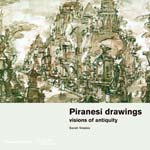 Courtesy of Thames & Hudson "Piranesi Drawings: Visions of Antiquity" by Sarah Vowles 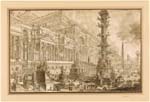 © The Morgan Library & Museum Architectural Fantasy with a Colossal Arcaded Faȧde on a Piazza with Statues, Victory Columns, Fountains, and an Obelisk, ca. 1740-50 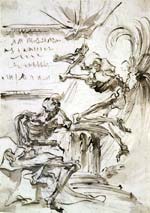 © The Trustees of the British Museum A frontispiece design with two skeletons in front of a tomb, c. 1746-47 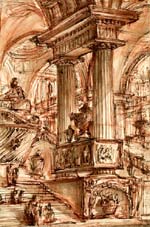 © The Trustees of the British Museum A monumental staircase in a vaulted interior with columns, c. 1750-55  © The Trustees of the British Museum The meeting of the Via Appia and the Via Ardeatina, seen at the second milestone outside the Porta Capena, c. 1750-56 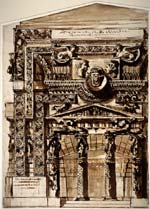 © The Trustees of the British Museum Fantastical façade of an antique building, c. 1765-69  © The Trustees of the British Museum View of the Strada Consulare with the Herculaneum Gate in Pompeii, c. 1772-78 |
© 2020 ArchNewsNow.com